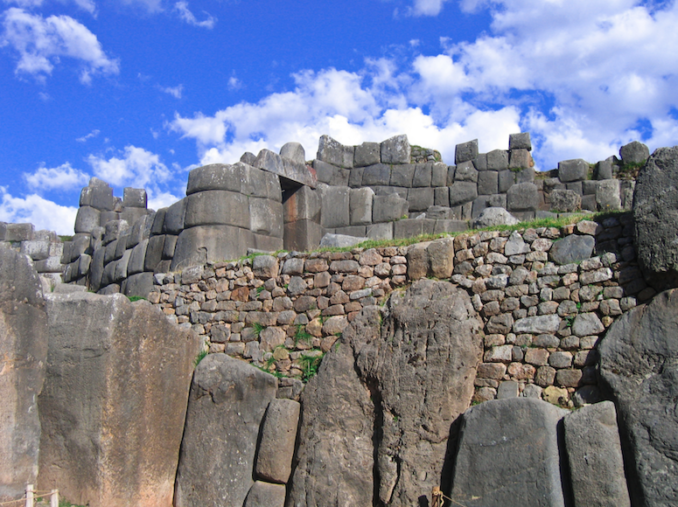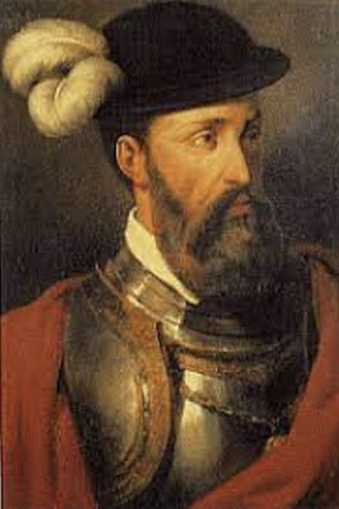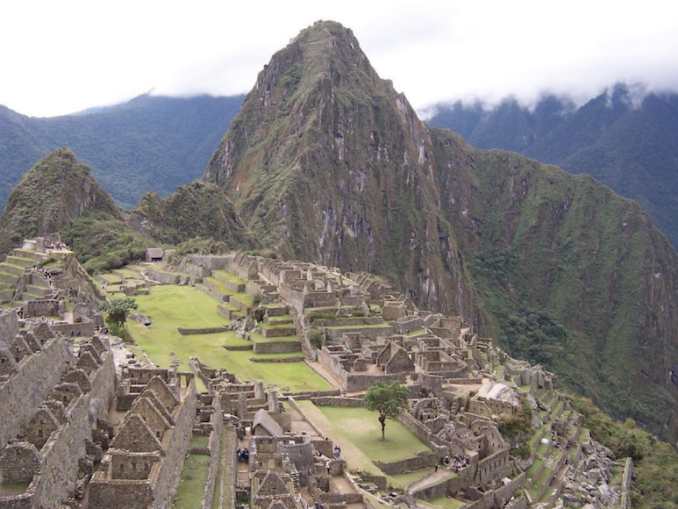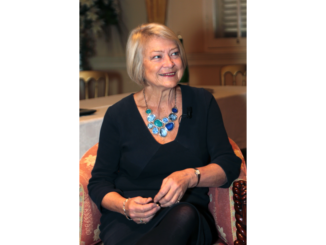More writings by uncle, John Alldridge. This time he is reporting from South America in 1960 for the Birmingham Evening Mail – Jerry F
The capital of the Inca Empire
I am very susceptible to atmosphere. I know instinctively whether or not I am going to like a place the moment I set foot in it.
I arrived at Cuzco early on a sunny spring morning. I should have been glad to see it. For the Panagra aircraft that had flown me up over the mountains from Lima was not pressurised. And so for an hour we had sat there, like so many Turkish pashas, sucking oxygen from long rubber tubes.

Cusco, Perú.,
Coletgoa – Licence CC BY-SA 2.5
And yet — despite the welcome taste of fresh air, the warmth of the sun, and the cheerful babble of Spanish all round me — I shivered. I felt as you sometimes feel when you wake up from a bad nightmare.
Cuzco today is just a small provincial town of 60,000, crumbling away in a sun-drenched valley 10,000ft. above sea level. Ten years ago it was shattered by an earthquake from which it is very slowly recovering. It still has a numbed, shocked look about it.
Yet once a million people lived here. This was the capital of an empire larger than Caesar’s, the heart and brain of one of the greatest planned societies the world has ever known.
They were a tall, hardy, hook-nosed people. We do not know their name, for they had no written language. So we call them, after their Supreme Being, their King-God, the Incas.
The Incas were masters of organisation. They turned conquest into empire. They began around A.D. 1100 in this single valley, surrounded by an infinite number of other tribes, small and great, of different, tongues and customs.
By 1500 they had absorbed them all into an empire that stretched from Argentina to Colombia, from the Pacific to the Upper Amazon.
Centuries before Lenin had worked it out, before Hitler had put it into practice, the Incas had established the perfect totalitarian state.
Conquered people were treated well if they agreed to accept the Inca way of life. They were expected to worship a common god — the sun — and learn to speak a common language, the Quechua of the Incas.
If not, they were liquidated or moved bodily hundreds of miles from their homes.
If you were prepared to accept this ironical philosophy life was not too bad under the Incas. Your working life was dedicated to the state. As an individual, of course, you ceased to exist: you worked in a group.
Ten of you formed a group. The group had a boss. Ten bosses had a supervisor.
And so on up the pyramid to the chief, who answered for 10,000 workers; to the governor of a province; to the ruler of one of the four quarters of the Inca Empire.
Finally to the Emperor himself, the Sapa-Inca.
As for the Inca, he was the State. He was the Sun-King. He was absolute. For he was God.
It was a class-conscious society. There was no nonsense about bettering yourself or getting on in the world. For one thing there was no money. The fabulous hoards of gold and silver had no value except to beautify the temples of the Sun God.
You paid no taxes. Instead you worked for the state — and fought for it when called on. In return the state provided you with everything you needed — with food, clothing, seed, tools, holidays — even free beer. In fact, this was “1984” five centuries before its time. You did what you were told and left the thinking to the Inca.
The Inca was the super-brain. And as you walk round Cuzco you realise that there was something almost supernatural about that brain.
It knew nothing about the wheel. It had never seen a horse or any sort of draught animal. It had no paper or pens to draw blueprints. And yet it was able to raise massive buildings so uniform in design, so perfectly fitted together, stone block by stone block, that even today you cannot slip a knife blade between them.
I think these vast Inca remains have impressed me more than anything I have seen in South America. More, even, than those cloud-topped towers in Sao Paulo or the new wonders of Brasilia. For they were built not for a generation or a century but for eternity.
I spent half a morning climbing over Sacsachuaman.

Inca ruins from Sacsayhuamán,
freestock.ca – Licence CC BY-SA 3.0
This is one of the most tremendous building projects ever raised by man. It was the great bastion, covering the heart of the Inca homeland. It took 70 years to build and 30,000 workmen laboured on it all that time.
It is an unbroken wall 300 yards long. It rises in a series of massive ramparts and parapets to a height of 60ft.
This huge strongpoint had only three entrances. And inside was a complete fortress system: an enormous reservoir, storehouses, barracks.
No wonder the hard-bitten Spaniards, when they saw it, were struck dumb with surprise-
“Neither the stone aqueduct of Segovia, nor the buildings of Hercules nor the work of the Romans had the dignity of this fortress.”
Four men – but they all had the same face!
The Incas had no horses or wheeled transport. Yet they built roads that are still an engineering wonder.
From the Sacred Square here in Cuzco four paved arterial roads radiated to the four corners of the empire. One, the Royal Road over the Andes, was 3,250 miles long —longer than the longest Roman road, which ran from Hadrian’s Wall, in Scotland, to Jerusalem (via the Channel and Mediterranean Sea, of course).
And to travel over those roads they produced a courier service of relay runners who could cover the distance from Quito to Cuzco in five days! And this at heights of from 6,000ft. to 13,000ft.
To delay the royal mail meant death to the runner.
So Big Brother Inca knew all almost as soon as it happened. Even fresh fish for the royal table was delivered the same day.
Yet this marvellous complex civilisation was destined to die in 33 minutes. The man who destroyed it was a stout-hearted blackguard called Francisco Pizarro. I saw his yellow skull leering up at me from his glass coffin in Lima Cathedral.

Portrait of Francisco Pizarro,
Urituguasi no! – Licence CC BY-SA 3.0
It was Pizarro’s good luck that he should arrive in Peru just as the vast top-heavy Inca Empire was divided by a bloody civil war.
Two rival Emperors had fought it out to the death. The survivor came to meet Pizarro and his Spaniards, flushed with success and confidence. For what had he to fear? The white men numbered less than 200. And he was God.
So he walked, unarmed, into the trap. A cannon blasted the brown bodies of his guard. And that was the end of an empire.
For without its brain the huge body could not function. The agonised messages sent up to the dying intelligence, as the Spaniards murdered, pillaged, raped, got no reply…
In Cuzco the Spaniards went berserk. They turned the great square of the city, Huacay-pata (in English it means, ironically, “Joy Square”) into a slaughterhouse. They violated the royal women. They tore the gold plate from the palace walls with their bare hands.
The square is still there. By day it is a pleasant place of high Spanish balconies and ornate churches. By night it is best avoided. The shadows lie too too thick.
And yet in the end it was the Incas who triumphed over the Spaniards. Within 10 years Pizarro was dead, murdered by one of his own men. There is little trace of him in Cuzco now. But the Incas are everywhere. In almost every street you see traces of that peerless stonemasonry.
The same crops they planted grow on those marvellous terraces. The royal bathwater still runs from a secret spring. The stone sentry boxes still face across the valley. A child’s slide, carved from the living rock, awaits the next joyride that will never come.
And the young people of Cuzco today make love in the same old Inca language. Mona Quiqui means “I love you.” If the girl is interested, she replies Ari!; if not, it’s Manan – nothing doing.”
When the earthquake struck suddenly on that Sunday afternoon 10 years ago it shattered Pizarro’s pompous cathedral and toppled the proud Spanish coat-of-arms. But the four square Inca blocks stood firm. A new town is building out of the old, very smart and modern. But its foundations are firmly planted on Inca stone.
I was taken into one of those musty, garish old churches to see a marvellous Crucifixion, carved by an Indian master craftsman long ago.
While I was studying it, a beggar — near naked and filthy — sidled up to me, hands cupped. Angrily the sacristan shooed him away.
And then I noticed an extraordinary thing: the guide, the sacristan, the beggar, the Indian Christ on the Cross, all had the same face, the hooked nose, the high cheekbones, the protuberant eyes, they were the same. It was the face of the eternal Inca.
On my last day in Peru I took the little railcar into the jungle and up the mountain to Machu Picchu.

General view, Machu Picchu, Peru.,
Jerry Daykin – Licence CC BY-SA 2.0
The story of how Machu Picchu was discovered reads like a lurid piece of schoolboy fiction. In 1911, a young American archaeologist, Hiram Bingham, was exploring a high escarpment, hemmed in by tall sugar-loaf peaks, when he stumbled by accident on a complete Inca city.
A fortified outpost, perched like an eagle’s eyrie among the clouds. It had been overlooked by the Spaniards and been buried in dense vegetable vegetation for ages.
When later expeditions began to clear these wonderful stone-walled guardrooms and storehouses, they made a strange and terrible discovery. The skeletons they found were all of women and children.
Were these refugees hidden here to save them from the Spaniards and mercifully killed when the garrison evacuated? The air up here is full of mysteries.
Reproduced with permission
© 2023 Newspapers.com
Jerry F 2023



